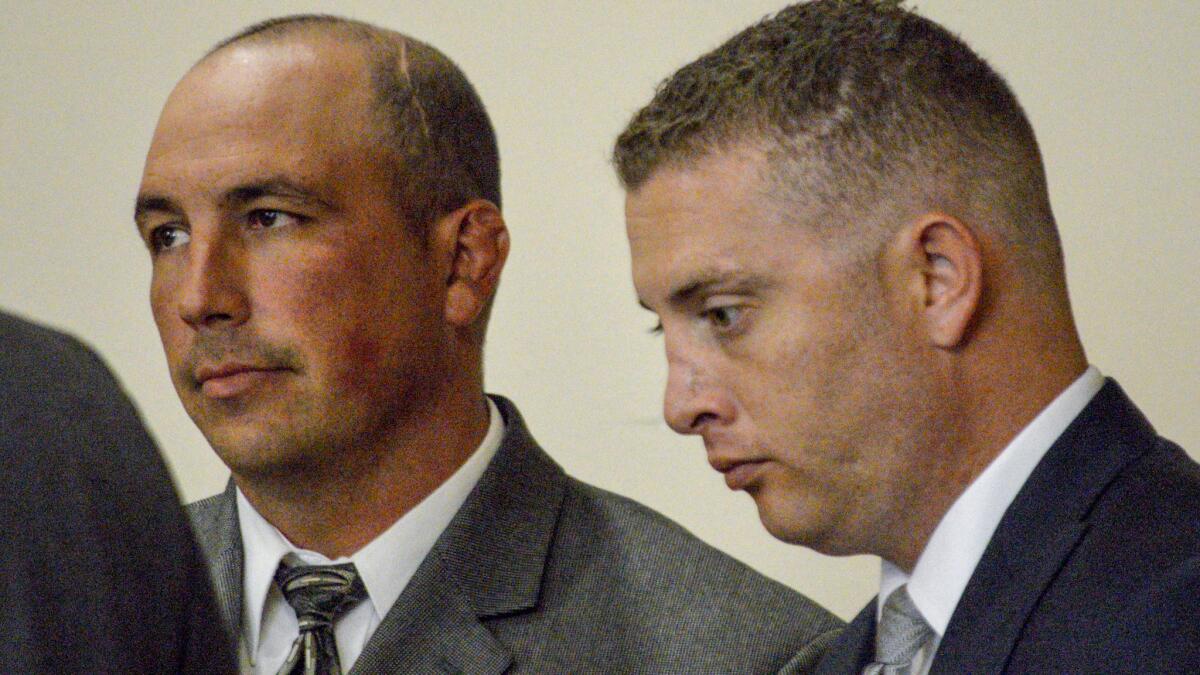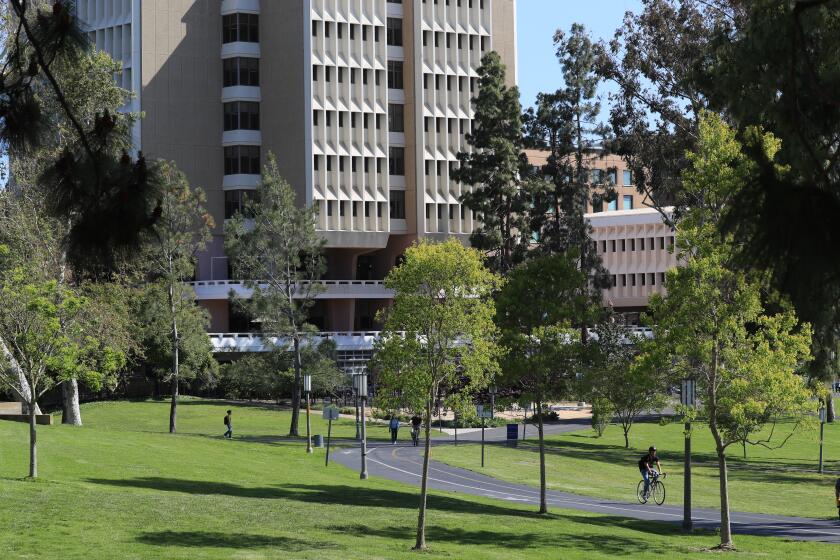Murder case against former New Mexico police officers ends in mistrial

- Share via
Reporting from Albuquerque — The case against two former New Mexico police officers charged in the death of a homeless man ended in a mistrial Tuesday when jurors told the judge they were hopelessly deadlocked on the counts of second-degree murder.
Judge Alisa Hadfield declared the mistrial after more than two days of deliberations in the case against Keith Sandy and Dominique Perez. Nine jurors wanted to acquit the men, and three were holding out for a guilty verdict.
Hadfield asked the jurors one by one if further deliberations would be fruitful, and they responded: “No, your honor.”
Special Prosecutor Randi McGinn said it would be up to the district attorney in Albuquerque to decide whether to retry the case. Defense lawyer Sam Bregman said he hoped prosecutors considered the 9-3 split in favor of acquittal and decided to not pursue another trial.
The courtroom was silent as the judge announced the mistrial, and the defendants left court without making a comment. Albuquerque police union members were seen tapping other officers on the shoulder and hugging each other after the news.
The trial in Albuquerque marked a rare effort by prosecutors to bring murder charges against officers, coming at a time when police shootings have rocked cities nationwide.
Sandy and Perez shot James Boyd, a mentally ill, homeless camper, in 2014 after receiving complaints that he was acting erratically on a rocky hillside. They were among 19 officers who swarmed the area with rifles, tactical gear, flash grenades, stun guns and K-9 units, a show of force that the prosecutor questioned throughout the trial.
The defendants said they opened fire because Boyd had two pocket knives and they believed he posed a deadly threat to a K-9 handler who had lost control of his police service dog and chased the animal, bringing him within 9 to 12 feet of Boyd.
If convicted, Sandy, 41, and Perez, 35, could have faced up to 15 years in prison for second-degree murder.
McGinn said she was not surprised that the 12-person jury was deadlocked, considering the shooting has divided the broader community in Albuquerque. She hopes the case leaves a lasting legacy, regardless of the next step.
“I think the discussion we have to have as a community is do we want Dirty Harry or do we want a peace officer,” she said. “I think we are beyond the Dirty Harry days.”
The decision on whether to retry the case will soon be in the hands of Raul Torrez, who is running unopposed for the district attorney position and takes office in January. The outgoing district attorney could not handle the case because of a conflict of interest with police.
Torrez said he was preparing a statement in response to the mistrial.
The mistrial followed 12 days of testimony that included the two former officers taking the witness stand to defend their actions and prosecutors outlining a series of fateful moves by police that escalated the encounter before Boyd’s death.
The case played out amid a national debate about police shootings and officers’ use of deadly force, including how to interact with mentally ill suspects.
Sandy and Perez were among 77 officers charged with murder or manslaughter in on-duty shooting deaths since 2005, according to data from Philip Stinson, a criminal justice professor at Bowling Green State University in Ohio. Twenty-six of those officers were convicted.
Officers and police experts were called to testify in the Albuquerque trial, with a prosecutor quizzing them on how police should have handled the standoff based on department protocols — starting with two officers with guns drawn responding to a report of Boyd’s illegal campsite. He drew the knives after they tried to pat him down, something the prosecutor said is known to agitate people with schizophrenia.
Defense attorneys argued the case was not about how police handled the encounter but whether Sandy and Perez were justified in shooting Boyd, saying they were at the mercy of decisions made by higher-ranking officers and a system that had made them into default mental health professionals.
The defense portrayed Boyd as a dangerous man with a history of violence that included assaults on officers. Sandy and Perez said police exhausted all options in negotiating with Boyd and had no other choice but to shoot once he made what they said was a menacing move toward the K-9 handler. Sandy shot Boyd twice in the arms, and Perez shot him in the back.
The shooting encapsulated the Albuquerque department’s troubles in the past several years. The U.S. Justice Department investigated more than 20 deadly police shootings between 2010 and 2014, leading to court-ordered reforms that included a new use-of-force policy and SWAT and crisis intervention training. The department also was found to have poor policies and training for officers encountering suspects who are mentally ill.
Frustration with Albuquerque police reached a boiling point after Boyd’s shooting. Protesters shut down City Hall and clashed with police, who deployed tear gas.
About two dozen activists arrived at the courthouse Tuesday to protest the mistrial, including one who carried a “wanted” poster for Sandy. They called for the case to be retried.
Javier Benavidez of the Southwest Organizing Project called the mistrial “heartbreaking” and said it “showed there are two sets of rules, for citizens and police officers.” The Rev. Frank Quintana of the Blessed Oscar Romero Catholic Community said the case shows Albuquerque still doesn’t care for residents suffering from mental illness or for the poor.
While protesters spoke on the courthouse steps, tactical officers stood on top of a building nearby.
More to Read
Sign up for Essential California
The most important California stories and recommendations in your inbox every morning.
You may occasionally receive promotional content from the Los Angeles Times.









